Logistics & SCM: Analyzing Business Strategies & Competition
VerifiedAdded on 2023/04/23
|7
|1485
|153
Report
AI Summary
This report provides a detailed analysis of logistics and supply chain management within a business context, focusing on key areas such as customer base identification, business unit goals, and competitive analysis. It explores methods for understanding customer needs, strategies for increasing the customer base, and the importance of analyzing past customer interactions. The report outlines short-term and long-term strategies for achieving business goals, including evaluating new product benefits and defining a clear company vision. Furthermore, it examines the competitive landscape, identifying opportunities such as outsourcing manufacturing and weaknesses like declining word-of-mouth advertising. Valuable resources, including staff and products, are also considered. This comprehensive analysis offers insights into optimizing logistics and supply chain management for enhanced business performance. Desklib offers a range of similar solved assignments and study resources for students.
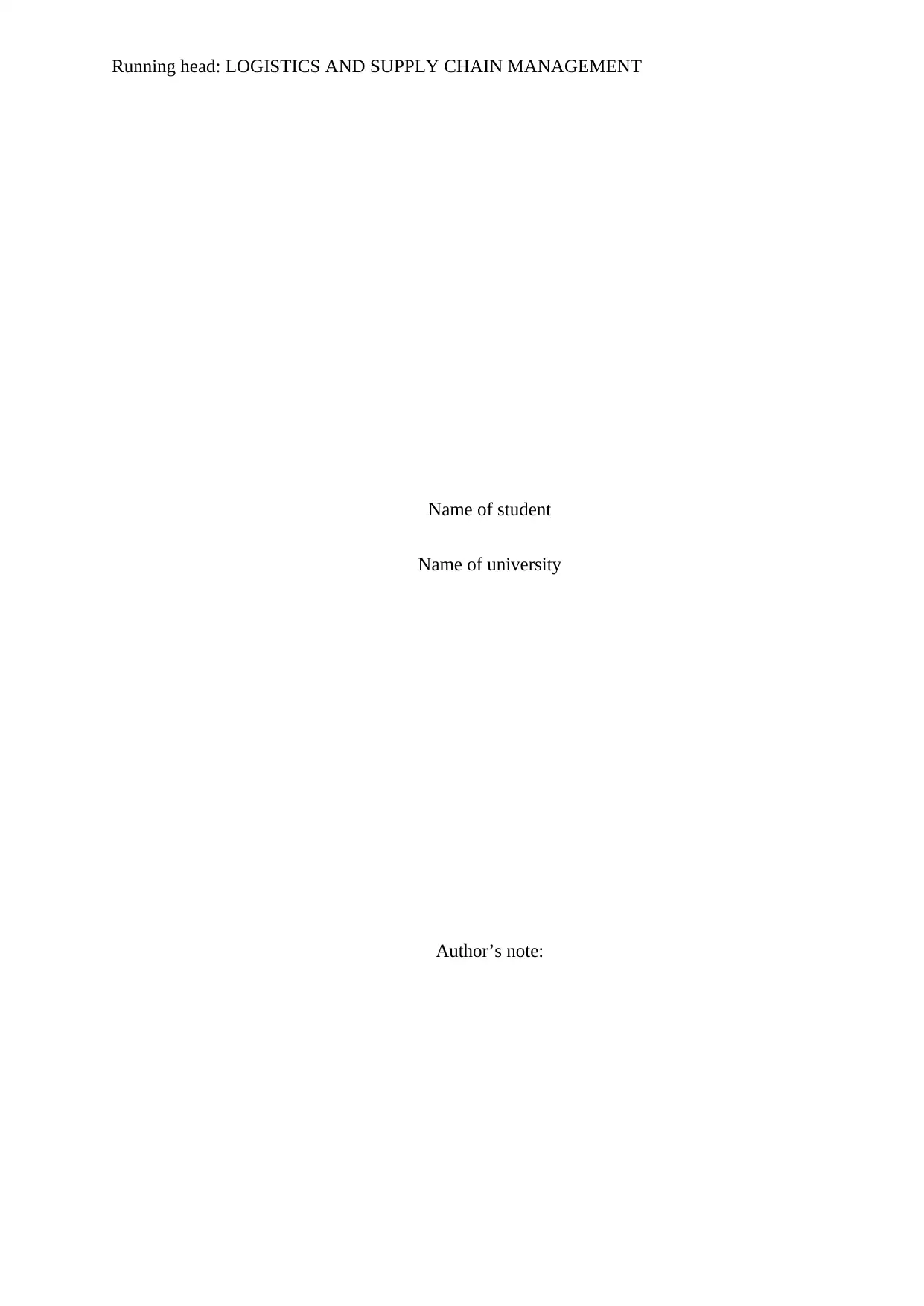
Running head: LOGISTICS AND SUPPLY CHAIN MANAGEMENT
Name of student
Name of university
Author’s note:
Name of student
Name of university
Author’s note:
Paraphrase This Document
Need a fresh take? Get an instant paraphrase of this document with our AI Paraphraser
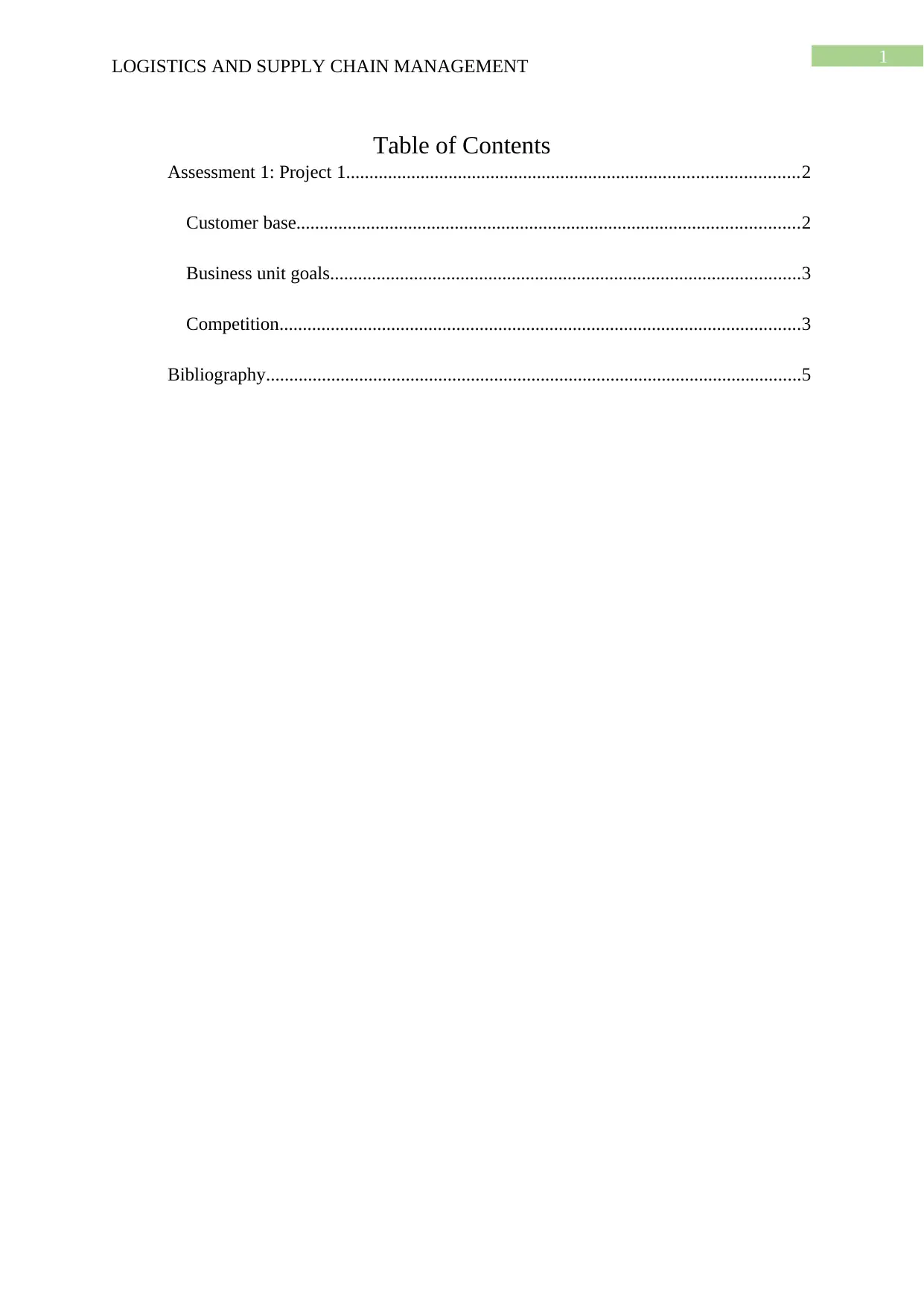
1
LOGISTICS AND SUPPLY CHAIN MANAGEMENT
Table of Contents
Assessment 1: Project 1.................................................................................................2
Customer base............................................................................................................2
Business unit goals.....................................................................................................3
Competition................................................................................................................3
Bibliography...................................................................................................................5
LOGISTICS AND SUPPLY CHAIN MANAGEMENT
Table of Contents
Assessment 1: Project 1.................................................................................................2
Customer base............................................................................................................2
Business unit goals.....................................................................................................3
Competition................................................................................................................3
Bibliography...................................................................................................................5
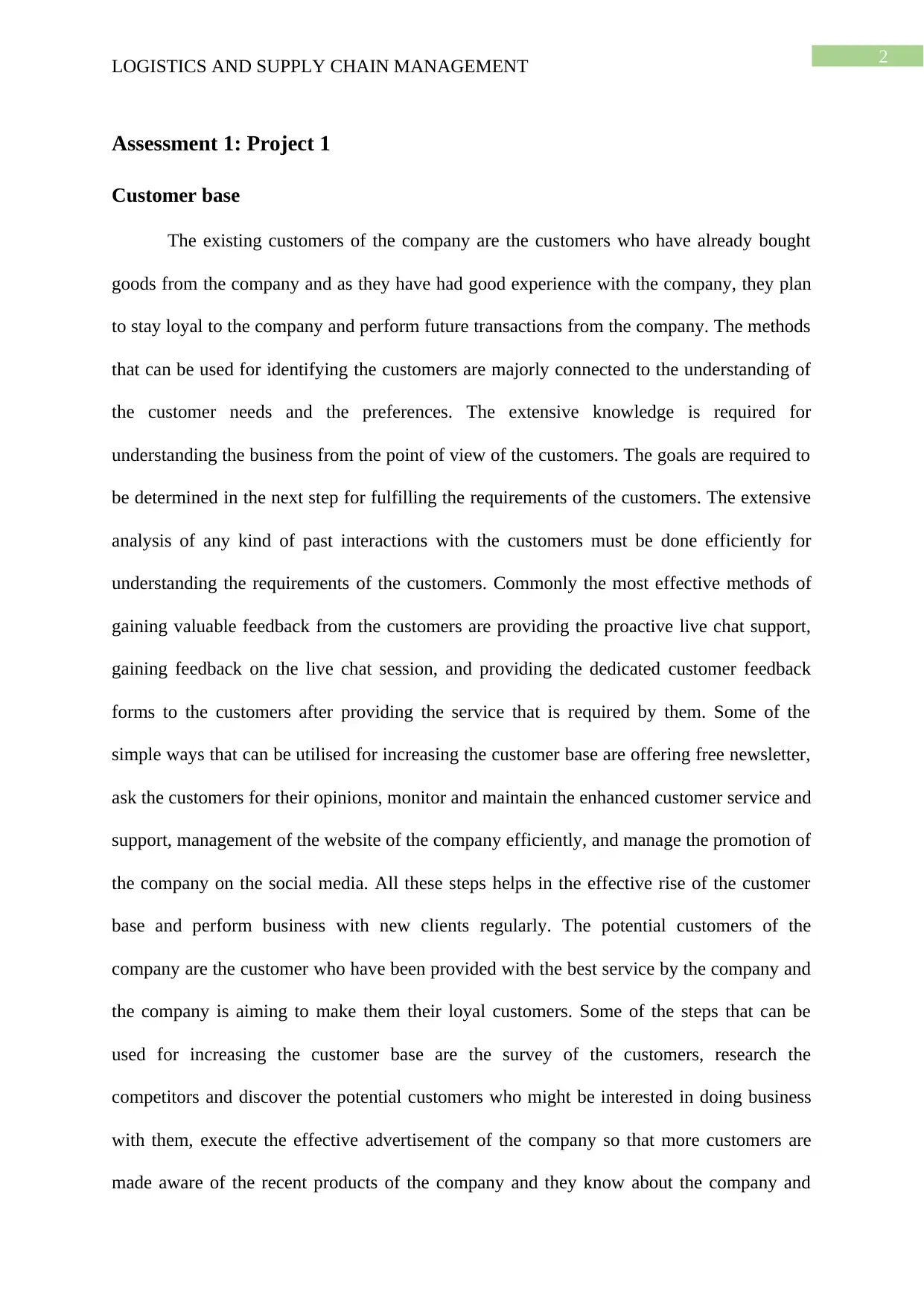
2
LOGISTICS AND SUPPLY CHAIN MANAGEMENT
Assessment 1: Project 1
Customer base
The existing customers of the company are the customers who have already bought
goods from the company and as they have had good experience with the company, they plan
to stay loyal to the company and perform future transactions from the company. The methods
that can be used for identifying the customers are majorly connected to the understanding of
the customer needs and the preferences. The extensive knowledge is required for
understanding the business from the point of view of the customers. The goals are required to
be determined in the next step for fulfilling the requirements of the customers. The extensive
analysis of any kind of past interactions with the customers must be done efficiently for
understanding the requirements of the customers. Commonly the most effective methods of
gaining valuable feedback from the customers are providing the proactive live chat support,
gaining feedback on the live chat session, and providing the dedicated customer feedback
forms to the customers after providing the service that is required by them. Some of the
simple ways that can be utilised for increasing the customer base are offering free newsletter,
ask the customers for their opinions, monitor and maintain the enhanced customer service and
support, management of the website of the company efficiently, and manage the promotion of
the company on the social media. All these steps helps in the effective rise of the customer
base and perform business with new clients regularly. The potential customers of the
company are the customer who have been provided with the best service by the company and
the company is aiming to make them their loyal customers. Some of the steps that can be
used for increasing the customer base are the survey of the customers, research the
competitors and discover the potential customers who might be interested in doing business
with them, execute the effective advertisement of the company so that more customers are
made aware of the recent products of the company and they know about the company and
LOGISTICS AND SUPPLY CHAIN MANAGEMENT
Assessment 1: Project 1
Customer base
The existing customers of the company are the customers who have already bought
goods from the company and as they have had good experience with the company, they plan
to stay loyal to the company and perform future transactions from the company. The methods
that can be used for identifying the customers are majorly connected to the understanding of
the customer needs and the preferences. The extensive knowledge is required for
understanding the business from the point of view of the customers. The goals are required to
be determined in the next step for fulfilling the requirements of the customers. The extensive
analysis of any kind of past interactions with the customers must be done efficiently for
understanding the requirements of the customers. Commonly the most effective methods of
gaining valuable feedback from the customers are providing the proactive live chat support,
gaining feedback on the live chat session, and providing the dedicated customer feedback
forms to the customers after providing the service that is required by them. Some of the
simple ways that can be utilised for increasing the customer base are offering free newsletter,
ask the customers for their opinions, monitor and maintain the enhanced customer service and
support, management of the website of the company efficiently, and manage the promotion of
the company on the social media. All these steps helps in the effective rise of the customer
base and perform business with new clients regularly. The potential customers of the
company are the customer who have been provided with the best service by the company and
the company is aiming to make them their loyal customers. Some of the steps that can be
used for increasing the customer base are the survey of the customers, research the
competitors and discover the potential customers who might be interested in doing business
with them, execute the effective advertisement of the company so that more customers are
made aware of the recent products of the company and they know about the company and
⊘ This is a preview!⊘
Do you want full access?
Subscribe today to unlock all pages.

Trusted by 1+ million students worldwide
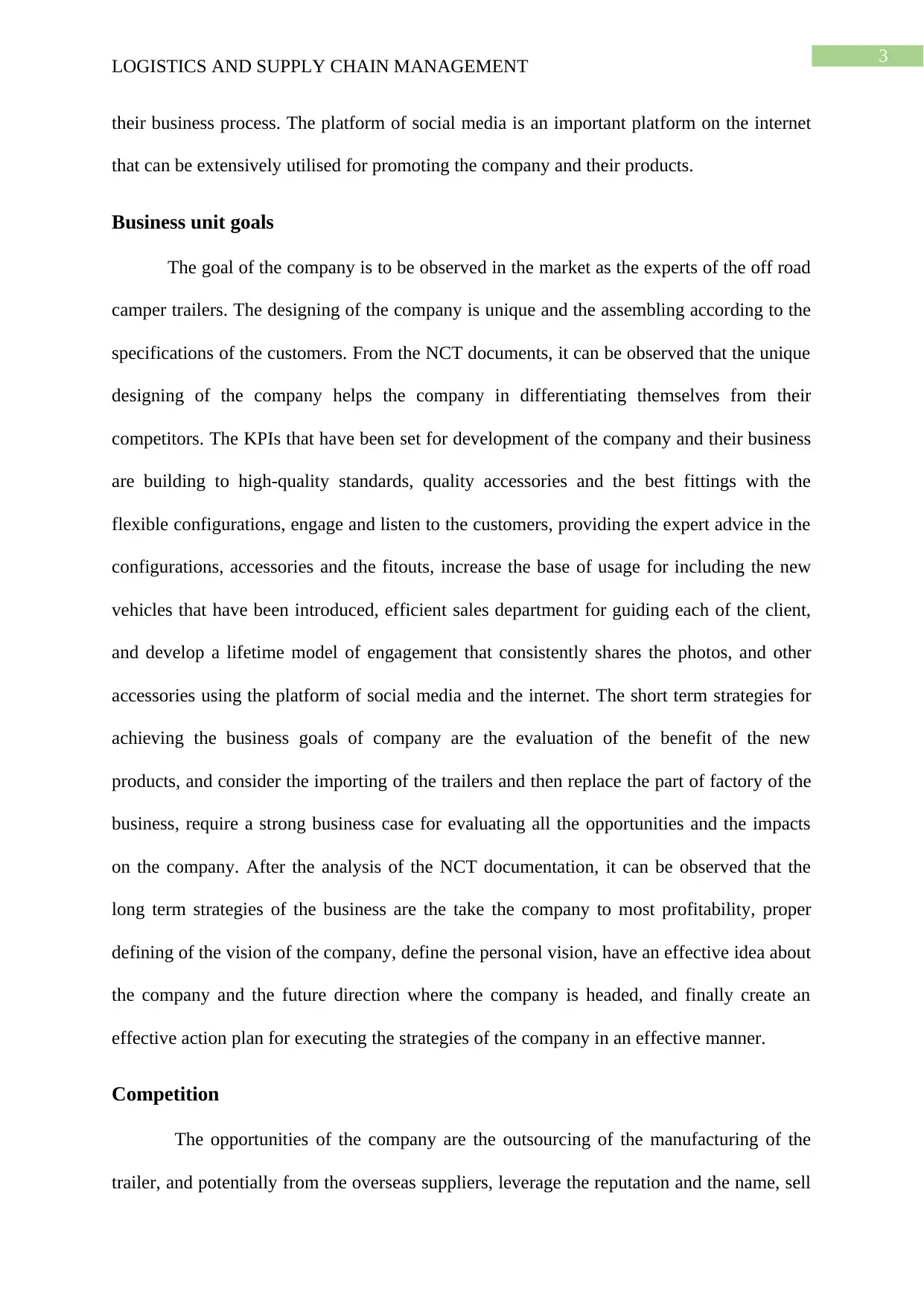
3
LOGISTICS AND SUPPLY CHAIN MANAGEMENT
their business process. The platform of social media is an important platform on the internet
that can be extensively utilised for promoting the company and their products.
Business unit goals
The goal of the company is to be observed in the market as the experts of the off road
camper trailers. The designing of the company is unique and the assembling according to the
specifications of the customers. From the NCT documents, it can be observed that the unique
designing of the company helps the company in differentiating themselves from their
competitors. The KPIs that have been set for development of the company and their business
are building to high-quality standards, quality accessories and the best fittings with the
flexible configurations, engage and listen to the customers, providing the expert advice in the
configurations, accessories and the fitouts, increase the base of usage for including the new
vehicles that have been introduced, efficient sales department for guiding each of the client,
and develop a lifetime model of engagement that consistently shares the photos, and other
accessories using the platform of social media and the internet. The short term strategies for
achieving the business goals of company are the evaluation of the benefit of the new
products, and consider the importing of the trailers and then replace the part of factory of the
business, require a strong business case for evaluating all the opportunities and the impacts
on the company. After the analysis of the NCT documentation, it can be observed that the
long term strategies of the business are the take the company to most profitability, proper
defining of the vision of the company, define the personal vision, have an effective idea about
the company and the future direction where the company is headed, and finally create an
effective action plan for executing the strategies of the company in an effective manner.
Competition
The opportunities of the company are the outsourcing of the manufacturing of the
trailer, and potentially from the overseas suppliers, leverage the reputation and the name, sell
LOGISTICS AND SUPPLY CHAIN MANAGEMENT
their business process. The platform of social media is an important platform on the internet
that can be extensively utilised for promoting the company and their products.
Business unit goals
The goal of the company is to be observed in the market as the experts of the off road
camper trailers. The designing of the company is unique and the assembling according to the
specifications of the customers. From the NCT documents, it can be observed that the unique
designing of the company helps the company in differentiating themselves from their
competitors. The KPIs that have been set for development of the company and their business
are building to high-quality standards, quality accessories and the best fittings with the
flexible configurations, engage and listen to the customers, providing the expert advice in the
configurations, accessories and the fitouts, increase the base of usage for including the new
vehicles that have been introduced, efficient sales department for guiding each of the client,
and develop a lifetime model of engagement that consistently shares the photos, and other
accessories using the platform of social media and the internet. The short term strategies for
achieving the business goals of company are the evaluation of the benefit of the new
products, and consider the importing of the trailers and then replace the part of factory of the
business, require a strong business case for evaluating all the opportunities and the impacts
on the company. After the analysis of the NCT documentation, it can be observed that the
long term strategies of the business are the take the company to most profitability, proper
defining of the vision of the company, define the personal vision, have an effective idea about
the company and the future direction where the company is headed, and finally create an
effective action plan for executing the strategies of the company in an effective manner.
Competition
The opportunities of the company are the outsourcing of the manufacturing of the
trailer, and potentially from the overseas suppliers, leverage the reputation and the name, sell
Paraphrase This Document
Need a fresh take? Get an instant paraphrase of this document with our AI Paraphraser
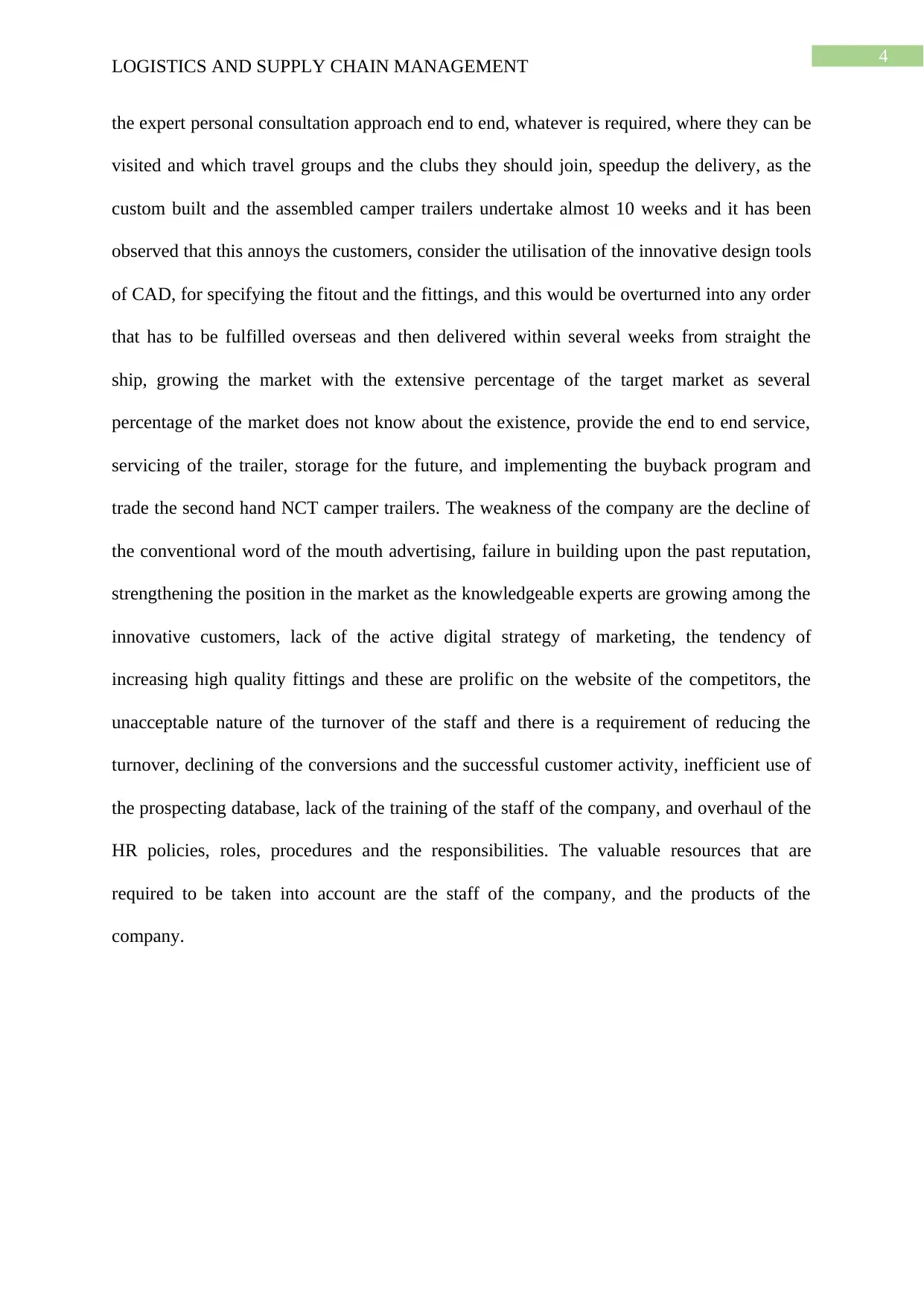
4
LOGISTICS AND SUPPLY CHAIN MANAGEMENT
the expert personal consultation approach end to end, whatever is required, where they can be
visited and which travel groups and the clubs they should join, speedup the delivery, as the
custom built and the assembled camper trailers undertake almost 10 weeks and it has been
observed that this annoys the customers, consider the utilisation of the innovative design tools
of CAD, for specifying the fitout and the fittings, and this would be overturned into any order
that has to be fulfilled overseas and then delivered within several weeks from straight the
ship, growing the market with the extensive percentage of the target market as several
percentage of the market does not know about the existence, provide the end to end service,
servicing of the trailer, storage for the future, and implementing the buyback program and
trade the second hand NCT camper trailers. The weakness of the company are the decline of
the conventional word of the mouth advertising, failure in building upon the past reputation,
strengthening the position in the market as the knowledgeable experts are growing among the
innovative customers, lack of the active digital strategy of marketing, the tendency of
increasing high quality fittings and these are prolific on the website of the competitors, the
unacceptable nature of the turnover of the staff and there is a requirement of reducing the
turnover, declining of the conversions and the successful customer activity, inefficient use of
the prospecting database, lack of the training of the staff of the company, and overhaul of the
HR policies, roles, procedures and the responsibilities. The valuable resources that are
required to be taken into account are the staff of the company, and the products of the
company.
LOGISTICS AND SUPPLY CHAIN MANAGEMENT
the expert personal consultation approach end to end, whatever is required, where they can be
visited and which travel groups and the clubs they should join, speedup the delivery, as the
custom built and the assembled camper trailers undertake almost 10 weeks and it has been
observed that this annoys the customers, consider the utilisation of the innovative design tools
of CAD, for specifying the fitout and the fittings, and this would be overturned into any order
that has to be fulfilled overseas and then delivered within several weeks from straight the
ship, growing the market with the extensive percentage of the target market as several
percentage of the market does not know about the existence, provide the end to end service,
servicing of the trailer, storage for the future, and implementing the buyback program and
trade the second hand NCT camper trailers. The weakness of the company are the decline of
the conventional word of the mouth advertising, failure in building upon the past reputation,
strengthening the position in the market as the knowledgeable experts are growing among the
innovative customers, lack of the active digital strategy of marketing, the tendency of
increasing high quality fittings and these are prolific on the website of the competitors, the
unacceptable nature of the turnover of the staff and there is a requirement of reducing the
turnover, declining of the conversions and the successful customer activity, inefficient use of
the prospecting database, lack of the training of the staff of the company, and overhaul of the
HR policies, roles, procedures and the responsibilities. The valuable resources that are
required to be taken into account are the staff of the company, and the products of the
company.
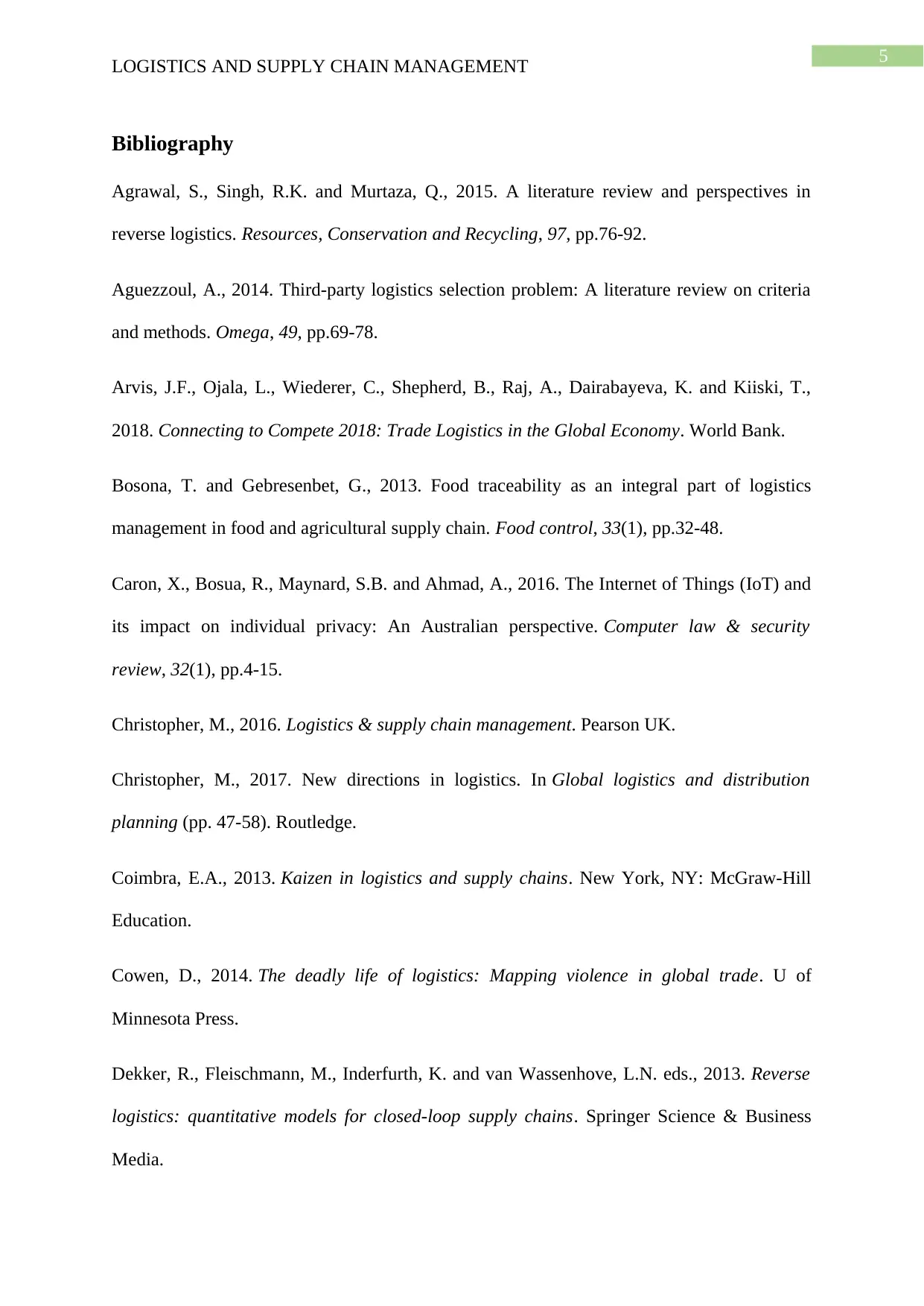
5
LOGISTICS AND SUPPLY CHAIN MANAGEMENT
Bibliography
Agrawal, S., Singh, R.K. and Murtaza, Q., 2015. A literature review and perspectives in
reverse logistics. Resources, Conservation and Recycling, 97, pp.76-92.
Aguezzoul, A., 2014. Third-party logistics selection problem: A literature review on criteria
and methods. Omega, 49, pp.69-78.
Arvis, J.F., Ojala, L., Wiederer, C., Shepherd, B., Raj, A., Dairabayeva, K. and Kiiski, T.,
2018. Connecting to Compete 2018: Trade Logistics in the Global Economy. World Bank.
Bosona, T. and Gebresenbet, G., 2013. Food traceability as an integral part of logistics
management in food and agricultural supply chain. Food control, 33(1), pp.32-48.
Caron, X., Bosua, R., Maynard, S.B. and Ahmad, A., 2016. The Internet of Things (IoT) and
its impact on individual privacy: An Australian perspective. Computer law & security
review, 32(1), pp.4-15.
Christopher, M., 2016. Logistics & supply chain management. Pearson UK.
Christopher, M., 2017. New directions in logistics. In Global logistics and distribution
planning (pp. 47-58). Routledge.
Coimbra, E.A., 2013. Kaizen in logistics and supply chains. New York, NY: McGraw-Hill
Education.
Cowen, D., 2014. The deadly life of logistics: Mapping violence in global trade. U of
Minnesota Press.
Dekker, R., Fleischmann, M., Inderfurth, K. and van Wassenhove, L.N. eds., 2013. Reverse
logistics: quantitative models for closed-loop supply chains. Springer Science & Business
Media.
LOGISTICS AND SUPPLY CHAIN MANAGEMENT
Bibliography
Agrawal, S., Singh, R.K. and Murtaza, Q., 2015. A literature review and perspectives in
reverse logistics. Resources, Conservation and Recycling, 97, pp.76-92.
Aguezzoul, A., 2014. Third-party logistics selection problem: A literature review on criteria
and methods. Omega, 49, pp.69-78.
Arvis, J.F., Ojala, L., Wiederer, C., Shepherd, B., Raj, A., Dairabayeva, K. and Kiiski, T.,
2018. Connecting to Compete 2018: Trade Logistics in the Global Economy. World Bank.
Bosona, T. and Gebresenbet, G., 2013. Food traceability as an integral part of logistics
management in food and agricultural supply chain. Food control, 33(1), pp.32-48.
Caron, X., Bosua, R., Maynard, S.B. and Ahmad, A., 2016. The Internet of Things (IoT) and
its impact on individual privacy: An Australian perspective. Computer law & security
review, 32(1), pp.4-15.
Christopher, M., 2016. Logistics & supply chain management. Pearson UK.
Christopher, M., 2017. New directions in logistics. In Global logistics and distribution
planning (pp. 47-58). Routledge.
Coimbra, E.A., 2013. Kaizen in logistics and supply chains. New York, NY: McGraw-Hill
Education.
Cowen, D., 2014. The deadly life of logistics: Mapping violence in global trade. U of
Minnesota Press.
Dekker, R., Fleischmann, M., Inderfurth, K. and van Wassenhove, L.N. eds., 2013. Reverse
logistics: quantitative models for closed-loop supply chains. Springer Science & Business
Media.
⊘ This is a preview!⊘
Do you want full access?
Subscribe today to unlock all pages.

Trusted by 1+ million students worldwide
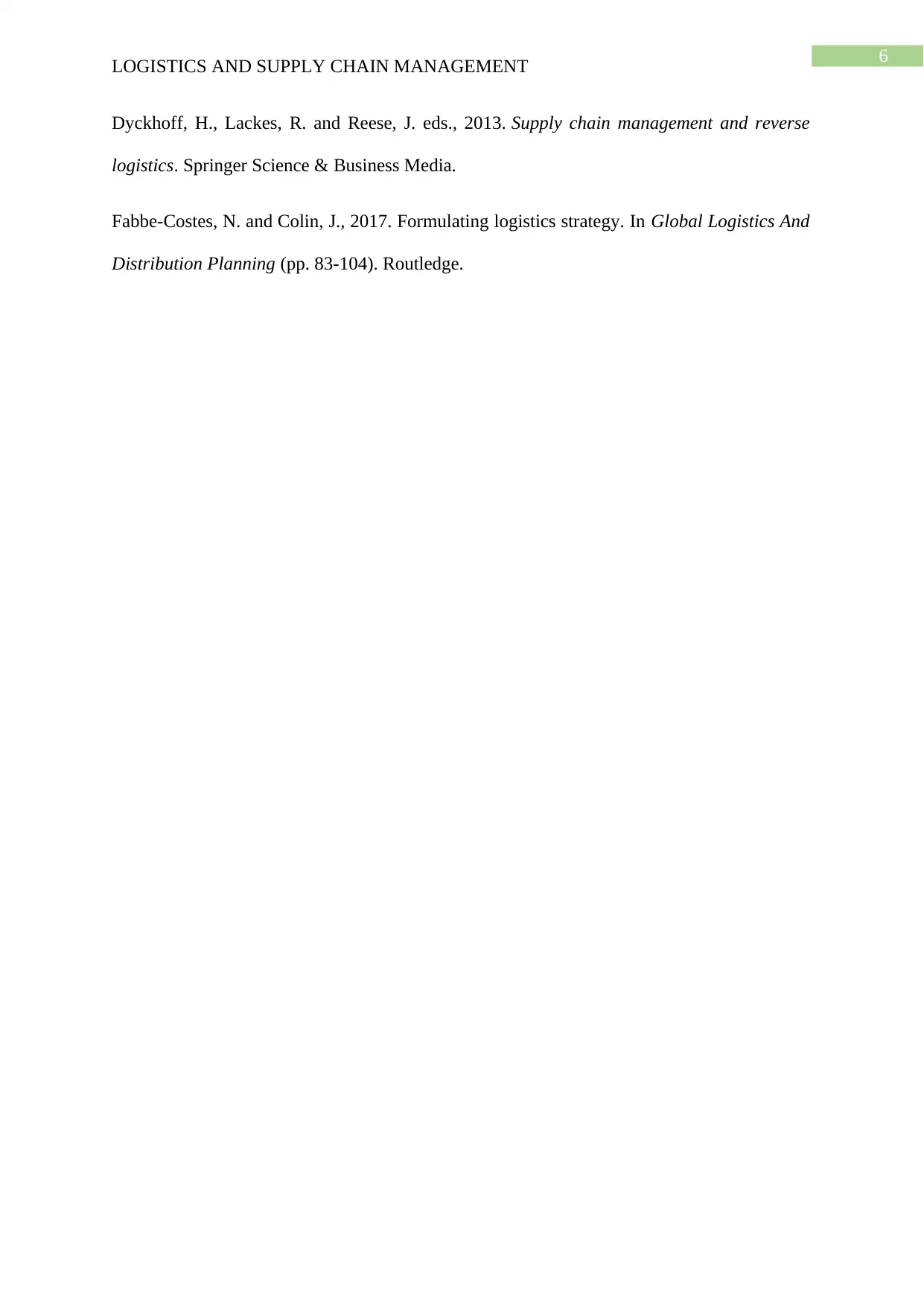
6
LOGISTICS AND SUPPLY CHAIN MANAGEMENT
Dyckhoff, H., Lackes, R. and Reese, J. eds., 2013. Supply chain management and reverse
logistics. Springer Science & Business Media.
Fabbe-Costes, N. and Colin, J., 2017. Formulating logistics strategy. In Global Logistics And
Distribution Planning (pp. 83-104). Routledge.
LOGISTICS AND SUPPLY CHAIN MANAGEMENT
Dyckhoff, H., Lackes, R. and Reese, J. eds., 2013. Supply chain management and reverse
logistics. Springer Science & Business Media.
Fabbe-Costes, N. and Colin, J., 2017. Formulating logistics strategy. In Global Logistics And
Distribution Planning (pp. 83-104). Routledge.
1 out of 7
Related Documents
Your All-in-One AI-Powered Toolkit for Academic Success.
+13062052269
info@desklib.com
Available 24*7 on WhatsApp / Email
![[object Object]](/_next/static/media/star-bottom.7253800d.svg)
Unlock your academic potential
Copyright © 2020–2025 A2Z Services. All Rights Reserved. Developed and managed by ZUCOL.




